The combination of a high-roof Olympic cab and Cummins' torquey
Page 39
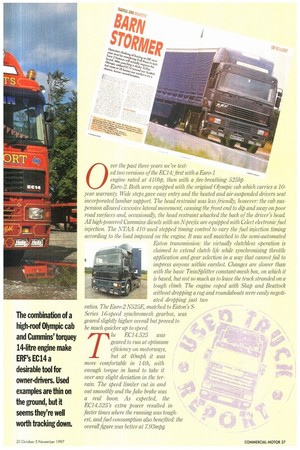
Page 38
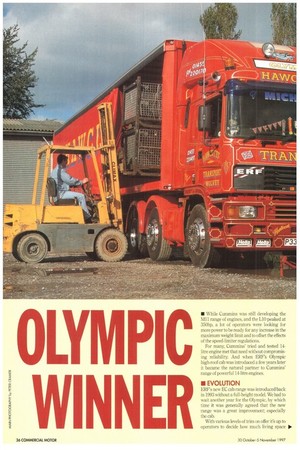
Page 40
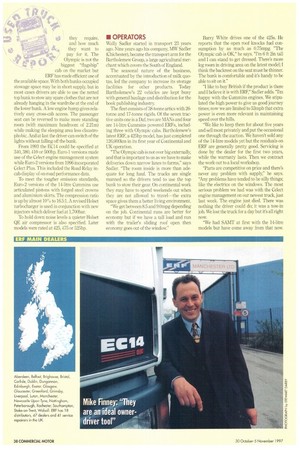
Page 41
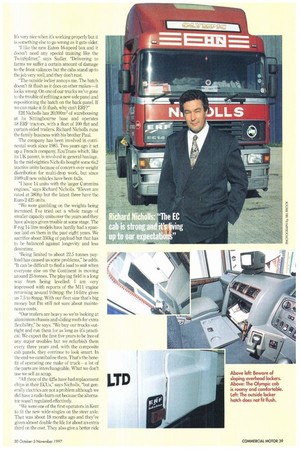
Page 42
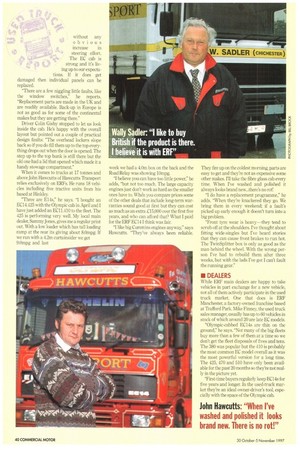
Page 43

If you've noticed an error in this article please click here to report it so we can fix it.
14-litre engine make ERF's EC14 a desirable tool for owner-drivers. Used examples are thin on the ground, but it seems they're well worth tracking down.
• While Ctunmins was still developing the M1 1 range of engines, and the I..10 peaked at 350hp, a lot of operators were looking for more power to be ready for any increase in the maximum weight limit and to offset the effects of the speed-limiter regulations.
For many, Cummins' tried and tested 14litre engine met that need without compromising reliability And when ERF's Olympic high-roof cab was introduced a few years later it became the natural partner to Cummins' range of powerful 14-litre engines.
• EVOLUTION
E,RF's new EC cab range was introduced back in 1993 without a full-height model. We had to wait another year for the Olympic, by which time it was generally agreed that the new range was a great improvement; especially the cab.
With various levels of trim on offer it's up to operators to decide how much living space
Over the past three years we've tested two versions of the EC14; first with a Euro-1 engine rated at 4mhp, then with a fire-breathing 525hp Euro-2. Both were equipped with the original Olympic cab which carries a 10year warranty Wide steps gave easy entry and the heated and air-suspended drivers seal incorporated lumbar support. The head restraint was less friendly, however: the cab suspension allowed excessive lateral movement, causing the front end to di P and sway on Poor road surfaces and, occasionally, the head restraint whacked the back of the driver's head All high-powered Cummins diesels with an N-prefix are equipped with Celect electronic fuel injection. The NTAA 410 used stepped timing control to vary the fuel injection timing according to the load imposed on the engine. It was well matched to the semi-automated Eaton transmission: the virtually clutchless operation is claimed to extend clutch lift while synchronising throttle application and gear selection in a way that cannot fail to impress anyone within earshot. Changes are slower than with the basic TwinSplitter constant-mesh box, on which it is based, but not so much as to leave the truck stranded on a tough climb. The engine coped with ShaP and Beattock without dropping a cog and roundabouts were easily negotiated dropping just two ratios. The Euro-2 N525E, matched to Eaton's 5
Series 16-speed synchromesh gearbox, was geared slight& higher overall but proved to be much quicker up to speed.
The EC14.525 was geared to run at optimum efficiency on ,notorways, but at 40mph it was more comfortable in 14th, with enough torque in hand to take it over any slight deviation in the terrain. The speed limiter cut in and out smoothly and the fake brake was a real boon. As expected, the EC14525's extra power resulted in faster times where the running was toughest, and fuel consumption also benefited: the overall figure was better at 7.93mpg
ligt they require. and how much
\ dltAy they want to pay for it. The to 0 0 N-7/ Olympic is not the biggest "flagship" cab on the market but ERF has made efficient use of the available space. With both bunks occupied stowage space may be in short supply, but in most cases drivers are able to use the netted top bunk to stow any spare clothes that are not already hanging in the wardrobe at the end of the lower bunk. A low engine hump gives relatively easy cross-cab access. The passenger seat can be reversed to make more standing room (with maximum headroom of 2.21m) while making the sleeping area less claustrophobic. And at last the driver can switch of the lights without falling off the bunk.
From 1993 the EC14 could be specified at 340, 380, 410 or 500hp. Euro-1 versions made use of the Celect engine management system while Euro-2 versions from 1996 incorporated Celect Plus. This included the Road Relay incab display of on-road performance data.
To meet the tougher emission standards, H:uro-2 versions of the 14-litre Cummins use articulated pistons with forged steel crowns and aluminium skirts. The compression ratio is up by almost 10% to 16.5:1. A revised Holset turbocharger is used in conjunction with new injectors which deliver fuel at 1,700ban To hold down noise levels a quieter Holset QE air compressor is also specified. Later models were rated at 425,475 or 525hp.
• OPERATORS
Wally Sadler started in transport 23 years ago. Nine years ago his company, MW Sadler (Chichester), became the transport arm for the Rartholemew Group, a large agricultural merchant which covers the South of England.
The seasonal nature of the business, accentuated by the introduction of milk quotas, led the company to increase its storage facilities for other products. Today Bartholemew's 22 vehicles are kept busy with general haulage and distribution for the book publishing industry.
The fleet consists of 38-tonne artics with 26tonne and 17-tonne rigids. Of the seven tractive units one is a Daf, two are MANs and four are 14-litre Cummins powered ERFs, including three with Olympic cabs. Bartholemew's latest ERF, a 425hp model, has just completed 126,000km in its first year of Continental and UK operation.
The Olympic cab is not over big externally, and that is important to us as we have to make deliveries down narrow lanes to farms," says Sadler. "The room inside is more than adequate for long haul. The trucks are single manned so the drivers tend to use the top bunk to stow their gear. On continental work they may have to spend weekends out when they are not allowed to travel—the extra space gives them a better living environment "We get between 8.5 and 9.0mpg depending on the job. Continental runs are better for economy but if we have a tall load and run with the trailer's sliding roof open then economy goes out of the window" Barry White drives one of the 425s. He reports that the open roof knocks fuel consumption by as much as 0.75mpg. "The Olympic cab is OK," he says. "I'm 6 ft 2in tall and I can stand to get dressed. There's more leg room in driving area on the latest model; think the backrest on the seat must be thinner. The bunk is comfortable and it's handy to be able to sit on it."
"I like to buy British if the product is there and I believe it is with ERF," Sadler adds. "I'm happy with the Cummins engines. We stipulated the high power to give us good journey times; now we are limited to 53mph that extra power is even more relevant in maintaining speed over the hills.
"We like to keep them for about five years and sell most privately and put the occasional one through the auction. We haven't sold any of the 14-litre models yet but the residuals on ERF are generally pretty good. Servicing is done by the dealer for the first two years, while the warranty lasts. Then we contract the work out to a local workshop.
"Parts are competitive on price and there's never any problem with supply," he says. "Any problems have tended to be silly things; like the electrics on the windows. The most serious problem we had was with the Celect engine management on our newest truck. just last week. The engine just died. There was nothing the driver could do; it was a tow-in job. We lost the truck for a day but it's all right now "We had SAMT at first with the 14-litre models but have come away from that now. It's very nice when it's working properly but it is something else to go wrong as it gets older.
"I like the new Eaton 16.speed box and it doesn't need any special training like the TwinSplitter," says Sadler. "Delivering to farms we suffer a certain amount of damage to the front valances but the cabs stand up to the job very well, and they don't rust.
"The outside locker annoys me. The hatch doesn't fit flush as it does on other makes—it looks wrong. On one of our trucks we've gone to the trouble of refitting a new side panel and repositioning the hatch on the back panel. If we can make it fit flush, why can't ERF?"
EH Nicholls has 20,000m2 of warehousing at its Sittingbourne base and operates 48 ERF tractors, with a fleet of 100 flat and curtain-sided trailers. Richard Nicholls runs the family business with his brother Paul.
The company has been involved in continental work since 1985. Two years ago it set up a French company, EcuTrans which, like its UK parent, is involved in general haulage. In the mid-eighties Nicholls bought some 6x2 tractive units because of concern over weight distribution for multi-drop work, but since 1989 all new vehicles have been 4x2s.
"I have 14 units with the larger Cummins engines," says Richard Nicholls. "Eleven are rated at 380hp but the latest three have the Euro-2 425 units.
"We were gambling on the weights being increased. I've tried out a whole range of smaller capacity units over the years and they have always given trouble at some stage. The F.reg 14-litre models have hardly had a spanner laid on them in the past eight years. We sacrifice about 350kg of payload but that has to be balanced against longevity and less downtime.
"Being limited to about 22.5 tonnes payload has caused us some problems," he adds. "It can be difficult to find a load to suit when everyone else on the Continent is moving around 25 tonnes. The playing field is a long way from being levelled. I am very impressed with reports of the Mll engine returning around 9.0mpg: the 14-litre gives us 7.5 to 8mpg. With our fleet size that's big money but l'm still not sure about maintenance costs.
"Our trailers are heavy so we're looking at aluminium chassis and sliding roofs for extra flexibility," he says. "We buy our trucks outright and run them for as long as it's practical. We expect the first five years to be free of any major troubles but we refurbish them every three years and, with the composite cab panels, they continue to look smart. In the end we cannibalise them. That's the bene fit of operating one make of truck a lot of the parts are interchangeable. What we don't use we sell as scrap.
"All three of the 425s have had replacement chips in their ECUs," says Nicholls, but generally &dries are not a problem although we did have a radio burn out because the alterna• tor wasn't regulated effectively.
"We were one of the first operators in Kent to fit the new wide-singles on the steer axle. That was about 18 months ago and they've given almost double the life for about an extra third on the cost. They also give a better ride without any obvious increase in steering effort.
The EC cab is strong and it's living up to our expectations. If it does get damaged then individual panels can be replaced.
"There are a few niggling little faults, like the window switches,'' he reports. "Replacement parts are made in the UK and are readily available. Back-up in Europe is not as good as for some of the continental makes but they are getting there."
Driver Cohn Gisby stopped to let us look inside the cab. He's happy with the overall layout but pointed out a couple of practical design faults: "The overhead lockers slope back so if you do fill them up to the top everything drops out when the door is opened. The step up to the top bunk is still there but the old one had a lid that opened which made it a handy stowage compartment."
When it comes to trucks at 17 tonnes and above John Hawcutts of Hawcutts Transport relies exclusively on ERFs. He runs 18 vehicles including five tractive units from his based at Hinkley.
"Three are E14s," he says. "I bought an EC14.425 with the Olympic cab in April and! have just added an EC11.410 to the fleet. The 425 is performing very well. My local main dealer, Sammy Jones, gives me a regular print out. With a low loader which has tall loading ramp at the rear its giving about 8.0mpg. If we run with a 4.2m curtainsider we get 9.0mpg and last week we had a 4.0m box on the back and the Road Relay was showing lOmpg.
"I believe you can have too little power," he adds, "but not too much. The large capacity engines just don't work as hard as the smaller ones have to. When you compare prices some of the other deals that include long-term warranties sound good at first but they can cost as much as an extra £15,000 over the first five years, and who can afford that? What I paid for the ERF ECI4 I think was fair.
"I like big Cummins engines anyway," says Hawcutts. "They've always been reliable. They fire up on the coldest morning, parts are easy to get and they're not as expensive some other makes. I'll take the fibre glass cab every time. When I've washed and polished it always looks brand new...there's no rot!
"I do have a replacement programme," he adds. "When they're knackered they go. We bring them in every weekend; if a fault's picked up early enough it doesn't turn into a big problem.
"Front tyre wear is heavy—they tend to scrub off at the shoulders. I've thought about fitting wide-singles but I've heard stories that they can cause front brakes to run hot. The TwinSplitter box is only as good as the man behind the wheel. With the wrong person I've had to rebuild them after three weeks, but with the lads I've got I can't fault the running gear."
• DEALERS
While ERF main dealers are happy to take vehicles in part exchange for a new vehicle, not all of them actively participate in the used truck market. One that does is ERF Manchester, a factory-owned franchise based at Trafford Park. Mike Finney, the used truck sales manager, usually has up to 60 vehicles in stock of which around 20 are late EC models.
"Olympic-cabbed EC14s are thin on the ground," he says. "Not many of the big fleets buy more than a few of them at a time so we don't get the fleet disposals of fives and tens. The 380 was popular but the 410 is probably the most common EC model overall as it was the most powerful version for a long time. The 425, 470 and 510 have only been available for the past 20 months so they're not really in the picture yet.
"First-time buyers regularly keep EC14s for five years and longer. In the used-truck market they're an ideal owner-driver's tool, especially with the space of the Olympic cab. "Fuel economy couldn't be said to be it's strong point," Finney adds. "It doesn't give the fuel economy of the lighter trucks but it's about the same as models with a similar power Output.
"But it does score as a long-term reliable engine. You might expect to be into a major rebuild on a smaller engine by a million kilometres but you wouldn't even be thinking about it with the 14-litre Cummins. We sell an engine repair kit for about COO. They go on for ever and parts are not expensive.
"Residuals for the whole of the EC range are strong," he says. "We're having to pay a premium of around £2,000 over book for the standard sleeper cab models—the Olympic, which is much rarer, will fetch an other £4,000 on top of that. A '94 M-reg EC14.410 6x2 with an Olympic cab retails at £35,000 and a 4x2 at £30,000."
• SUMMARY
Olympic-cabbed EC14s are thin on the ground but well sought after in the used truck market. They're not the sole preserve of the franchised dealer but only the occasional example will appear on independent dealers' forecourts, as most are still too pricey.
The 14-litre Cummins engine's reputation for reliability lives on but it has come more under attack in an environment where fuel costs seem to be everything. There is a balance to be struck, however, and if the extra power means making the ferry on time or an extra load once in a while then it may still tip the scales in its favour.
I-I by Bill Brock
SPECIFICATIONS
MODEL: ERF EC 14.41ST 4)(2 tractive unit with high-roof Olympic sleeper cab Design GCW: 44 tonnes. Manufacturer: ERF, Sun works, Sandbach, Cheshire.
ENGINE: Cummins Euro-1 NTAA 410 air-to-air charge-cooled direct injection with SIC (stepped timing control).
Cylinders: Six, in line.
Capacity: 14 litres.
Maximum net power: 307kW (410hp) at 1,900rpm. Maximum net torque: 1,821Nm(1,342114t) at 1,200rpm.
TRANSMISSION: Eaton SAMT with 1513612 12-speed constant-mesh gearbox.
Clutch: 430mm, twin-plate, ceramic.
BRAKING SYSTEM: Full-air dual system with Cat 1 ABS, air dryer and drive-axle load sensing. Parking: Spring brake on both axles. Engine brake: Jacobs.
STEERING: ZF 8098 Servocom recirculating ball with integral power assistance.
CHASSIS: Pressed-steel-channel side and cross-members; bolted and rivetted construction.
Suspension: Front, steel taper leaf springs; rear, four-bag air suspension with anti-roll bars front and rear.
Wheelbase: 3.8m.
Wheels and tyres: 8.25x22.5 10-stud steel rims with 295/80 22.5 tyres. Fuel tank: 3601it (80gal).
ELECTRICAL SYSTEM: 24V, 2x00Ah batteries Generator: 55A alternator.
PARTS PRICES
Manufacturer's parts prices (retail ex-VAT) Laminated windscreen £152.00 Injector set(service exchange) £189.00 Piston liner set £340.00 Rear brake chamber £145.00 Complete headlamp unit £67.50 Wiper blades, complete set £9.10 Engine oil filter £17.98 Complete clutch assembly(exchange) £570.00 Door mirror £77.50
WORKSHOP TIMES
Manufacturer's standard workshop times Replace clutch assembly 6.0 Replace injector set 2.9 Replace head gasket (all) 11.1 Replace brakes, front and rear 5.0 Remove and replace engine 16.5 Remove and replace gearbox 4.5 Renew engine oil and filters 0.5
ROADTESTS
ERF EC14.52 21.09.95 ERF E14.4151 01.09.94












































































































